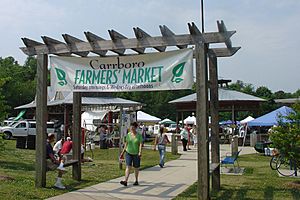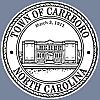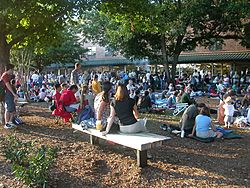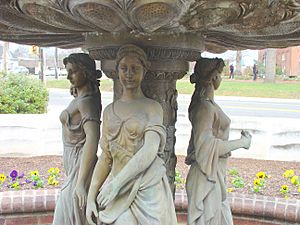Carrboro, North Carolina facts for kids
Quick facts for kids
Town of Carrboro, North Carolina
|
|||
|---|---|---|---|

The Carrboro Farmers' Market (2007)
|
|||
|
|||
| Nickname(s):
The Paris of the Piedmont, Shadow City
|
|||
| Motto(s):
"Feel Free"
|
|||

Location of Carrboro, North Carolina
|
|||
| Country | United States | ||
| State | North Carolina | ||
| County | Orange | ||
| Settled | 1882 | ||
| Incorporated | 1911 | ||
| Named for | Julian Shakespeare Carr | ||
| Government | |||
| • Type | Council–manager | ||
| Area | |||
| • Total | 6.51 sq mi (16.85 km2) | ||
| • Land | 6.47 sq mi (16.77 km2) | ||
| • Water | 0.03 sq mi (0.08 km2) | ||
| Elevation | 489 ft (149 m) | ||
| Population
(2020)
|
|||
| • Total | 21,295 | ||
| • Density | 3,288.80/sq mi (1,269.73/km2) | ||
| Time zone | UTC−5 (EST) | ||
| • Summer (DST) | UTC−4 (EDT) | ||
| ZIP code |
27510
|
||
| Area code(s) | 919 | ||
| FIPS code | 37-10620 | ||
| GNIS feature ID | 2405383 | ||
| Website | townofcarrboro.org | ||
Carrboro is a town in Orange County in the U.S. state of North Carolina. The population was 21,295 at the 2020 census. The town, which is part of the Raleigh-Durham-Chapel Hill combined statistical area, was named after North Carolina industrialist Julian S. Carr.
Located directly west of Chapel Hill, home of the University of North Carolina's flagship campus, Carrboro has a reputation as one of the most progressive communities in the Southeastern United States. It was the first municipality in North Carolina to elect an openly gay mayor (Michael R. Nelson in 1995) and the first municipality in the state to grant domestic-partner benefits to same-sex couples. In October 2002, Carrboro was among the first municipalities in the South to adopt resolutions opposing the Iraq War and the USA PATRIOT Act.
Contents
History
The history of Carrboro is similar to the history of many mill towns in North Carolina and largely parallels the histories of the State University Railroad and the Alberta Cotton Mill. Located just west of Chapel Hill, Carrboro was originally known as West End. It was settled in 1882 near the railway depot at the terminus of the 10.2 mile State University Railroad spur from University Station in Glenn, North Carolina. State statute had decreed that the railway depot be at least one mile (1.6 km) from the university campus to discourage students from leaving on the weekends and spending their money elsewhere. Settlement in West End increased after 1898 when Thomas F. Lloyd of Chapel Hill built a steam-powered grist mill near the depot. This would become the Alberta Cotton Mill, and in 1900 the town briefly called itself Lloydville in his honor.
Durham businessman Julian Shakespeare Carr bought the mill and other nearby buildings in 1909, adding them to the chain of mills that became Durham Hosiery Mills. In 1911, West End was incorporated and named Venable in honor of chemistry professor and University of North Carolina president Francis Preston Venable, but only two years later was renamed Carrboro, after Carr provided electric power for the community and expanded the mill. In addition to the university and the textile mills, the railroad depot in Carrboro also served the local lumber industry, and in the 1920s and 1930s Carrboro became a major hub in the hardwood cross-tie market.
A 1920s building boom in Carrboro sparked by a fire in the downtown business district ended as business at the Durham Hosiery Mills declined towards the end of the decade. The Great Depression also took an economic toll and in 1930 the company closed Mill No. 4, the original Alberta Cotton Mill. Passenger service on the train line ended in 1936. In 1938 Durham Hosiery Mills closed Mill No. 7, across Main Street from Mill No. 4, and ceased operations altogether.
During World War II, Mill No. 7 became the site of a munitions factory. After the war, Pacific Mills bought both Mills No. 4 and 7 and operated them as Carrboro Woolen Mills. When Pacific Mills closed in the mid-1960s - the final activity at the mill was sorting and shipping BVD underwear - Carrboro was no longer able to depend upon the textile industry to sustain itself. The University of North Carolina and other businesses in the area were growing rapidly and provided work in a wide range of occupations and locations.
The mill remained abandoned for nearly a decade and changed hands several times. In 1975 the owner, with the assent of the Carrboro Board of Aldermen, intended to have it demolished. A community petition and fund-raising effort provided for its restoration as Carr Mill Mall.
In addition to the Alberta Mill Complex, the Carrboro Commercial Historic District, Thomas and Mary Hogan House, and Thomas F. Lloyd Historic District are listed on the National Register of Historic Places.
Geography
Carrboro is located at 35°55′14″N 79°5′2″W / 35.92056°N 79.08389°W (35.920422, -79.083933).
According to the US Census Bureau, the town has a total area of 6.5 square miles (16.8 km2), of which 6.4 square miles (16.7 km2) is land and 0.03 square miles (0.08 km2) is water.
Postally, Carrboro's 27510 zip code is an island within Chapel Hill's 27514 zip code.
Climate
Carrboro typically has a North American humid subtropical climate. Summer conditions are hot and humid, with daily average high temperatures of 85 °F (29 °C) and higher. Winter temperatures tend to remain above or well above freezing, though snowfall does happen and occasional snow and ice storms are not unusual. The average high temperature in July, the hottest month of the year, is 89 °F (32 °C), and the average high temperature in January, the coldest month, is 49 °F (9 °C). Average monthly precipitation ranges from 3.2 to 4.5 inches (8.1 to 11.4 cm), with the heaviest precipitation occurring during the summer months.
| Climate data for Carrboro, North Carolina | |||||||||||||
|---|---|---|---|---|---|---|---|---|---|---|---|---|---|
| Month | Jan | Feb | Mar | Apr | May | Jun | Jul | Aug | Sep | Oct | Nov | Dec | Year |
| Mean daily maximum °F (°C) | 49 (9) |
52 (11) |
62 (17) |
71 (22) |
78 (26) |
85 (29) |
89 (32) |
87 (31) |
82 (28) |
72 (22) |
63 (17) |
53 (12) |
70 (21) |
| Mean daily minimum °F (°C) | 26 (−3) |
28 (−2) |
36 (2) |
44 (7) |
53 (12) |
61 (16) |
65 (18) |
64 (18) |
57 (14) |
45 (7) |
37 (3) |
29 (−2) |
45 (8) |
| Average precipitation inches (mm) | 3.7 (94) |
3.9 (99) |
4.2 (110) |
3.2 (81) |
4.5 (110) |
4.4 (110) |
4.1 (100) |
4.4 (110) |
3.2 (81) |
3.5 (89) |
3.5 (89) |
3.5 (89) |
46.0 (1,170) |
| Source: Weatherbase | |||||||||||||
Demographics
| Historical population | |||
|---|---|---|---|
| Census | Pop. | %± | |
| 1920 | 1,129 | — | |
| 1930 | 1,242 | 10.0% | |
| 1940 | 1,455 | 17.1% | |
| 1950 | 1,795 | 23.4% | |
| 1960 | 1,997 | 11.3% | |
| 1970 | 5,058 | 153.3% | |
| 1980 | 7,336 | 45.0% | |
| 1990 | 12,134 | 65.4% | |
| 2000 | 16,782 | 38.3% | |
| 2010 | 19,582 | 16.7% | |
| 2020 | 21,295 | 8.7% | |
| 2021 (est.) | 21,312 | 8.8% | |
| U.S. Decennial Census | |||
2020 census
| Race | Number | Percentage |
|---|---|---|
| White (non-Hispanic) | 13,238 | 62.16% |
| Black or African American (non-Hispanic) | 2,142 | 10.06% |
| Native American | 39 | 0.18% |
| Asian | 1,881 | 8.83% |
| Pacific Islander | 10 | 0.05% |
| Other/Mixed | 1,262 | 5.93% |
| Hispanic or Latino | 2,723 | 12.79% |
As of the 2020 United States census, there were 21,295 people, 9,358 households, and 4,640 families residing in the town.
2010 census
As of the census of 2010, there were 19,582 people, 8,625 households, and 4,020 families residing in the town. The population density was 3,018.9 people per square mile (1,165.6/km2). There were 9,258 housing units at an average density of 1,424.3 per square mile (551.1/km2). The racial makeup of the town was 70.9% White, 10.1% African American, 0.4% Native American, 8.2% Asian, 0.004% Pacific Islander, 7.5% some other race, and 2.9% from two or more races. Hispanic or Latino people of any race were 13.8% of the population.
There were 8,625 households, out of which 26.2% had children under the age of 18 living with them. 34.5% of all households were headed by married couples living together, 8.8% had a female householder with no husband present, and 53.4% were non-families. 35.5% of all households were made up of individuals, and 5.3% had someone living alone who was 65 years of age or older. The average household size was 2.27 and the average family size was 3.07.
In the town, the population was spread out, with 21.5% under the age of 18, 15.6% from 18 to 24, 36.1% from 25 to 44, 21.7% from 45 to 64, and 5.3% who were 65 years of age or older. The median age was 30.1 years. For every 100 females, there were 93.7 males. For every 100 females age 18 and over, there were 91.5 males.
Economy
Over the period 2008–2012, the median income for a household in the town was $45,159, and the median income for a family was $73,893. Males had a median income of $28,622 versus $26,198 for females. The per capita income for the town was $32,604. About 11.9% of families and 16.1% of the population were below the poverty line, including 21.4% of those under age 18 and 11.4% of those age 65 or over.
Diversity
In the early 1990s, a sizable influx of Latino immigrants began moving to Carrboro, attracted by jobs in the building and service trades. The Hispanic population of Carrboro increased by 936% between 1990 and 2003, to 12% of the Carrboro population. As these immigrants settled in Carrboro, they brought the food and culture of their native countries to the town. Carrboro is now home to three Latino tiendas (grocery stores). Other businesses, including national grocery chains like Food Lion, adapted to the change in demographics by stocking a wider variety of Central and South American food products.
The Human Rights Center serves the Latinos, day laborers, Burmese and Karen populations. It petitioned the town government to adopt the Universal Declaration of Human Rights, which it did in 2009.
As with neighboring Chapel Hill, affordable housing has become a pressing local issue.
Arts and culture
Attractions
One of Carrboro's attractions is the Carrboro Farmer's Market, which features local organic produce, locally produced cheeses, baked goods, and handmade crafts. Created in 1977, the Market was one of the first in the area to link farmers directly with their customers. The Market requires that everything sold must be produced within a 50-mile (80 km) radius of Carrboro. In addition to the Carrboro Farmers Market, the town eateries and specialty food shops have also garnered regional and national acclaim for their strong support of locally produced food. Carrboro is a favorite destination of UNC students for its relatively large number and diversity of restaurants. In 2005, Carrboro was named one of the 100 best art towns in America.
Two music venues that host national and regional acts are located in Carrboro. The ArtsCenter has featured nationally known roots music acts, such as David Lindley, Leon Russell, and Dr. John as well as internationally known artists including Richard Thompson and k.d. lang. The ArtsCenter also holds art classes, dance classes, and art exhibitions. It was founded 1974 and moved from Main Street to its new location on Roberson Street summer 2023. The Cat's Cradle, open for more than 50 years, hosts a diverse range of national and international musicians and performers like Nirvana, Public Enemy, John Mayer, Joan Baez, and Iggy Pop.
The 84-seat Dirty South Institute (DSI) Comedy Theater in Carrboro, opened in 2006, boasted a local company of 50+ active performers and a national network of comedians. It was the home of the DSI Comedy School, which offered classes to the public every month in the art of improv, stand-up and sketch comedy. Amid scandal, DSI Comedy Theater closed on August 28, 2017. The space re-opened a few months later as the PIT Chapel Hill, a branch of the Peoples Improv Theater founded by Ali Reza Farahnakian, a former “Saturday Night Live” writer and UNC alumnus.
The Carrboro Historic District, north of downtown, contains the distinctive architecture of the approximately 150 mill houses built by Lloyd and Carr for the mill workers at the Alberta Cotton Mill and their families. Many of these homes have since been razed, but numerous others have been restored; a number of these homes, centered on Shelton Street, are occupied by (particularly graduate) students at the nearby University of North Carolina at Chapel Hill, however, increasing housing costs have resulted in a downwards trend in the student population of this area.
Annual cultural events
The town is known for the Carrboro Music Festival, a free all-day event which celebrates local music with over 150 acts performing at dozens of locations in the downtown area. The music festival began in 1998 as the Fête de la Musique, and was held on the summer solstice. In 2002, the name of the event was changed to the Carrboro Music Festival and, in order to increase attendance by avoiding the summer heat, moved to the fall. In 2013, the festival expanded to two days. Carrboro is also home to the annual West End Poetry Festival, which draws in a great selection of local poets.
In November, Carrboro hosts its annual film festival. The Carrboro Film Festival was started in 2006 by Carrboro Arts Committee members Jackie Helvey and Nic Beery, with support from Board of Aldermen and the Carrboro Recreation and Parks Department. The idea behind the Carrboro Film Festival is to promote local area shorts films that are twenty minutes or less. The first year, there were nearly 100 entires. From those, a day filled with fabulous films was created, and that tradition has continued over the years. In 2013, the festival expanded to two days, accepting submissions from across the entire state of North Carolina and beyond.
Carrboro has also had a yearly Pride Promenade, where a rainbow goat is escorted down to the town commons where food trucks, Drag shows and other events take place.
Libraries
Carrboro is home to two branches of the Orange County Public Library System: the Carrboro Branch Library and the Carrboro Cybrary. Carrboro Branch Library is located in McDougle Elementary and Middle School. Services include a medium-sized circulating collection of books, audiobooks, movies on DVD and VHS, and music CDs; computer and Internet access; magazines; and local and national newspapers. Carrboro Cybrary is located in the Century Center in downtown Carrboro. Services include a small circulating collection of contemporary fiction, nonfiction, audiobooks, and Spanish and English language learning materials; computer, Internet, and wireless access; magazines; and local and national newspapers. Orange County residents may access these services free of charge, and nonresidents may access the computers free of charge.
Sports
Carrboro is home to some of the originators of the modern hooping movement. In 2001, Vivian Spiral began hooping on the Weaver Street Market lawn during the weekly music events. Julia Hartsell joined her for the 2002 music season. Jonathan Baxter, founder of the HoopPath, also lives and teaches hooping in Carrboro. The first annual HoopPath Retreat was held Carrboro in 2007 and still happens there every year. The Hoop Convergence, started in 2008, is also held annually in Carrboro and the surrounding area. Synergy FlowArts, a manufacturer of hoops and other flow props, was formed in 2010.
Parks and recreation
Carrboro has 11 parks, from large community parks to small neighborhood parks and play areas. The 55-acre (220,000 m2) Henry Anderson Community Park contains multiple lighted baseball fields, basketball courts, tennis courts, a large fenced dog park, a 2.4 acre fishing pond and other recreational facilities. The Adams Tract is a 27-acre (110,000 m2) urban forest area near the center of town that contains 1.25 miles (2.01 km) of trails for walking and hiking. The Dr. Martin Luther King Jr. Park (10.2 acres) was planned with public input and opened in January 2020. It contains a multi-purpose field, community garden, bicycle pump track, play equipment, amphitheater, pavilions.[1][2] Several neighborhood parks and other facilities provide multipurpose fields, playground equipment and restrooms. Athletic fields, meeting rooms, kitchen, and pavilions are available for reservation
Education
The Chapel Hill-Carrboro City Schools manages public primary and secondary education for more than 11,000 students in and around Carrboro and Chapel Hill. The Chapel Hill-Carrboro Public Schools consistently rank as number one in North Carolina in terms of graduation rate, test scores and percentage of college-bound seniors. Elementary school students in Carrboro attend Carrboro Elementary School, McDougle Elementary School, Morris Grove Elementary School, Frank Porter Graham Elementary School, or Seawell Elementary School. Middle school students in Carrboro attend Culbreth Middle School, McDougle Middle School, or Smith Middle School. High school students living in Carrboro attend either Carrboro High School or Chapel Hill High School.
Media
Carrboro is served, along with Chapel Hill, by WCHL Radio (1360 AM, 97.9 FM) and its associated website chapelboro.com. Both communities are also served by the Chapel Hill News, a subsidiary of the Raleigh News & Observer, and the student newspaper at the University of North Carolina, The Daily Tar Heel.
In June 2004, WCOM began broadcasting at 103.5 FM in Carrboro and is streamed live over the internet at wcomfm.org. WCOM is a low-power FM (LPFM) radio station entirely volunteer-run featuring locally produced music and community affairs programming.
The Carrboro Citizen was a locally owned community newspaper based in Carrboro. Launched in March 2007, the Citizen was published weekly (on Thursdays) and was distributed free throughout town and the surrounding area. In 2012, the Citizen's owners sought a new owner to continue publication, but a buyer was not found. Its 290th and final issue was published on October 4, 2012.
Notable people
- Jonathan Byrd, singer-songwriter
- Elizabeth 'Libba' Cotten, folk guitarist and author of "Freight Train"
- Whammy Douglas, Major League Baseball player
- Jesse Kalisher, photographer
- Anne-Claire Niver, singer-songwriter
- Joanna Pearson, novelist, poet, short-story writer
- Dexter Romweber, singer-songwriter
- Eliza McLamb, singer-songwriter
Nickname
Carrboro's nickname, "The Paris of the Piedmont," stems from a sardonic comment by John Martin, a reporter for the Chapel Hill Weekly. In 1970, Nyle Frank, now a musician but then a graduate student in political science at the nearby University of North Carolina, organized an alternative "Invisible University," and announced plans to have himself crowned as the institution's "King" in Carrboro. Martin commented, "I can see it now − The Paris of the Piedmont."
Sister cities
Carrboro has four sister cities:
 Celaya, Guanajuato, Mexico
Celaya, Guanajuato, Mexico Juventino Rosas, Guanajuato, Mexico
Juventino Rosas, Guanajuato, Mexico San Jorge, Nicaragua
San Jorge, Nicaragua Saratov, Russia
Saratov, Russia
See also
 In Spanish: Carrboro para niños
In Spanish: Carrboro para niños






